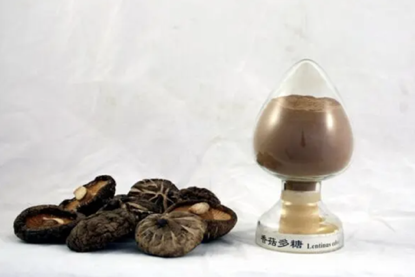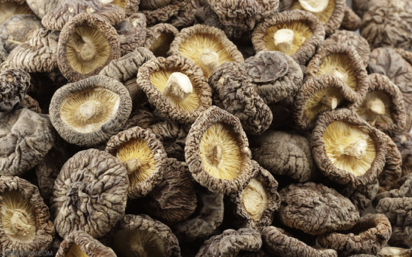Shiitake mushrooms are not only rich in nutrients but also have special medicinal effects. Studies have shown that shiitake mushrooms contain various bioactive substances such as shiitake mushrooms polysaccharides and shiitake polysaccharide-proteins, making them ideal immune enhancers with cancer-inhibiting and anti-tumor effects.
Extraction Methods of Mushroom Polysaccharides
Many foreign scholars in the 1980s conducted extensive research on the preparation and extraction methods of shiitake polysaccharides. The extraction of shiitake polysaccharides has been reported, with the main methods including hot water extraction, acid extraction, alkali extraction, microwave-assisted extraction, and complex enzyme hydrolysis, each having its limitations. Below, we introduce the process of several extraction methods:
1. Shiitake mushrooms Polysaccharide Extraction Process
1.1 Conventional Extraction Process: Raw material → Water (or acid) extraction → Extract → Vacuum concentration → Concentrated liquid → Alcohol precipitation → Precipitate → Sevage method for deproteinization → Aqueous phase → Ethanol washing → Crude polysaccharide product.
1.2 Using Complex Enzymatic Hydrolysis: Raw material → Complex enzymatic hydrolysis → Enzymatic solution → Vacuum concentration → Concentrated liquid → Alcohol precipitation → Precipitate → Ethanol washing → Crude polysaccharide product.
1.3 Acid Treatment Combined with Hot Water Extraction: Raw material → Complex enzymatic hydrolysis → Enzymatic solution → Water extraction → Acid extraction → Extract → Vacuum concentration → Concentrated liquid → Alcohol precipitation of precipitate → Sevage method deproteinized aqueous phase → Ethanol washing → Crude polysaccharide product.
Operational Details
2.1 Raw Material Pretreatment: Select quality shiitake mushrooms, grind them into a powder using a high-speed plant mill, take 5g of shiitake mushroom powder per portion, add an appropriate amount of alcohol to make a paste.
2.2 Hot Water Soaking: Add 20 times the volume of distilled water to the shiitake treatment material and soak at 40°C for 4 hours. Freeze overnight in a freezer. Remove the shiitake soaking liquid from the freezer, thaw, and then extract separately for 30, 60, and 90 minutes in a constant temperature water bath, filter through four layers of gauze and collect the filtrate. Add 20 times the volume of distilled water to the residue for another extraction, boil for the same duration, filter, and combine the two filtrates.
2.3 Acid Extraction: Add hydrochloric acid solution to the shiitake treatment material to make the final concentration 0.3 mol/L, 0.4 mol/L, 0.5 mol/L, respectively, and extract at 60°C for 8 hours, neutralize with an appropriate amount of NaOH to neutrality, filter, and concentrate.
2.4 Complex Enzymatic Extraction: Add 0.1g of cellulase and 0.5g of pectinase to the shiitake treatment material, with the aim of hydrolyzing the cell surface structure and intercellular connectors to dissolve some sugar substances. After enzymatic treatment, add 20 times the volume of distilled water and soak at 40°C for 80 minutes, then boil for 90 minutes and filter to obtain the filtrate. Centrifuge to precipitate, concentrate the supernatant, and precipitate with ethanol.
2.5 Combined Enzymatic-Acid-Hot Water Extraction: Add 0.1g of cellulase and 0.5g of pectinase to the shiitake treatment material, with the aim of hydrolyzing the cell surface structure and intercellular connectors. Add 20 times the volume of water, soak at 40°C for 80 minutes, then boil for 60 minutes, filter through four layers of gauze, collect the filtrate, adjust pH to 4.5, 5.0, 5.5 for acid extraction, and then filter again. Combine the two filtrates and concentrate.
2.6 Vacuum Concentration: Concentrate the above filtrate using a rotary evaporator at 75°C and 0.09Pa atmospheric pressure. Collect the concentrated liquid and centrifuge at 6000rpm for 15 minutes to remove proteins and impurities, obtaining the supernatant.
2.7 Alcohol Precipitation Separation: Add 4 times the volume of 95% alcohol to the concentrated liquid to precipitate the shiitake polysaccharides as a flocculent gel, while most proteins and other components remain in solution. Centrifuge at 7000rpm for 15 minutes to obtain the precipitate.
2.8 Sevage Method for Deproteinization: Dissolve the above precipitate in an appropriate amount of distilled water, add 20% by volume of chloroform and 7% by volume of isopentanol to form a flocculent precipitate, centrifuge at 5000rpm for 15 minutes to obtain the precipitate. Repeat the operation until no precipitate is formed.
The exploration and refinement of various extraction methods for shiitake mushroom polysaccharides demonstrate the ongoing efforts to harness the full potential of this remarkable natural resource. Each method, with its unique advantages and limitations, contributes to a deeper understanding of how to effectively isolate these valuable polysaccharides.




















Follow Us